

Regenesis Group. Articles Working Regeneratively Across Scales by Beatrice Benne and Pamela Mang.
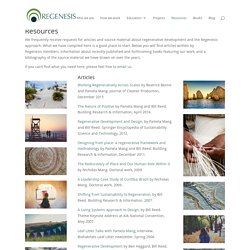
Journal of Cleaner Production, December 2015 The Nature of Positive by Pamela Mang and Bill Reed. Building Research & Information, April 2014. The Bioregion: A New Frame for Designing the Next Economy. By: John Thackara In myriad projects around the world, a new economy is emerging whose core value is stewardship, not extraction.
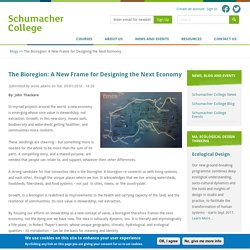
Growth, in this new story, means soils, biodiversity and watersheds getting healthier, and communities more resilient. These seedlings are cheering – but something more is needed for the whole to be more than the sum of its parts. Child Education Catalogue: Learn to Sort & Recycle Magnetic Game. Child Education Catalogue: Early Recycling Sorting Game. Linda Booth Sweeney > Learning About Systems. Learning about systems isn’t always easy.
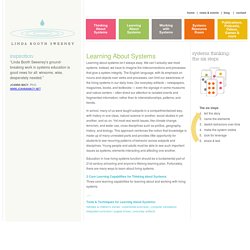
We can’t actually see most systems. Instead, we have to imagine the interconnections and processes that give a system integrity. The English language, with its emphasis on nouns and objects over verbs and processes, can limit our awareness of the living systems in our daily lives. Our everyday artifacts – newspapers, magazines, books, and textbooks — even the signage in some museums and nature centers – often direct our attention to isolated events and fragmented information, rather than to interrelationships, patterns, and trends.
In school, many of us were taught subjects in a compartmentalized way, with history in one class, natural science in another, social studies in yet another, and so on. Education in how living systems function should be a fundamental part of 21st century schooling and anyone’s lifelong learning plan. Linda Booth Sweeney > Publications, Podcasts, Videos, Games & more. Downloads and links to publications and materials by Linda Booth Sweeney.

Books: The Systems Thinking Playbook. Curriculum Materials - Cool Australia. Nature Connections - Making Maps - Early Learning - Cool Australia. Quick summary: Children will be led on a series of journeys around their local neighbourhood and will be encouraged to observe the world around them, including local sights, terrain and directions.
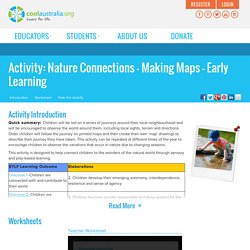
Older children will follow the journey on printed maps and then create their own ‘map’ drawings to describe their journey they have taken. This activity can be repeated at different times of the year to encourage children to observe the variations that occur in nature due to changing seasons. This activity is designed to help connect children to the wonders of the natural world through sensory and play-based learning. Please note: This activity is designed to take place in a local park, bushland area or wild space (beach, forest, creek, or bush). INSIDE A TOOTH — Rachel Ignotofsky Design. Tiny Terrariums — Rachel Ignotofsky Design. CELLS — Rachel Ignotofsky Design. Plant antaomy — Rachel Ignotofsky Design. Object Lessons - Essays. Finding Solace in a Storage Unit The facilities occupy a complicated place in American life.
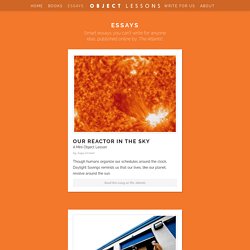
We refuse to let go of our possessions, even as our lives propel us away from them. Our stuff and our hearts are hard to separate. How to Vanquish the Automated Towel Dispenser A Mini Object Lesson The toilet is the ultimate venue of control. The Slow Death of the Political Bumper Sticker Why the campaign staple has been falling out of favor Sales of bumper stickers have been dropping. How Millennials (Almost) Killed the Wine Cork A new generation of wine drinkers came of age with screw caps and plastic bottle stoppers, but cork producers are mounting a campaign to win their loyalty.
Though it has recaptured some market share in recent years, the cork industry is now fighting against the newly discovered appeal of plastic and aluminum. Systems Thinking literature exhibition at… Terrarium, USBG. Olivier Issaly. BIOSPHERE 2. Biospheres. Biosphere 2, Oracle, Arizona, USA. Looking for a new way to abuse plantlife, I p… Stu_spivack. How Wolves Change Rivers. Wolves are crucial for maintaining a healthy ecosystem -- a fact that was conveniently forgotten when they were exterminated from almost all of the continental United States by ranchers, farmers, trappers and hunters.
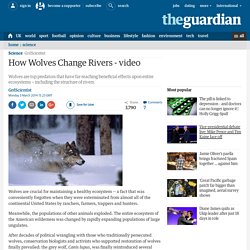
Meanwhile, the populations of other animals exploded. The entire ecosystem of the American wilderness was changed by rapidly expanding populations of large ungulates. After decades of political wrangling with those who traditionally persecuted wolves, conservation biologists and activists who supported restoration of wolves finally prevailed: the grey wolf, Canis lupus, was finally reintroduced several areas in the northern Rocky Mountains of the United States. One of those release areas was Yellowstone National Park. Wolf Reintroduction Changes Ecosystem. On a quiet spring morning, a resounding “Slap!”
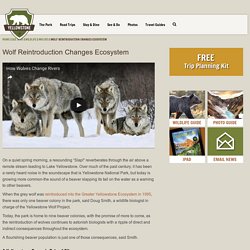
Reverberates through the air above a remote stream leading to Lake Yellowstone. Over much of the past century, it has been a rarely heard noise in the soundscape that is Yellowstone National Park, but today is growing more common-the sound of a beaver slapping its tail on the water as a warning to other beavers. When the grey wolf was reintroduced into the Greater Yellowstone Ecosystem in 1995, there was only one beaver colony in the park, said Doug Smith, a wildlife biologist in charge of the Yellowstone Wolf Project. Today, the park is home to nine beaver colonies, with the promise of more to come, as the reintroduction of wolves continues to astonish biologists with a ripple of direct and indirect consequences throughout the ecosystem. A flourishing beaver population is just one of those consequences, said Smith. George Monbiot: For more wonder, rewild the world. How Wolves Change Rivers. Has The Reintroduction Of Wolves Really Saved Yellowstone?
<img class="full-width" style="" typeof="foaf:Image" width="1000" height="692" alt="" data-smsrc="<a pearltreesdevid="PTD497" rel="nofollow" href=" class="vglnk"><span pearltreesdevid="PTD498">http</span><span pearltreesdevid="PTD500">://</span><span pearltreesdevid="PTD502">www</span><span pearltreesdevid="PTD504">.
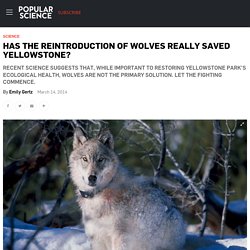
EcoTone: news and views on ecological science. A well-publicized depiction of wolves revitalizing Yellowstone’s ecosystem is a myth, said writers for the NY Times‘ op-ed page and a Nature news feature last week.
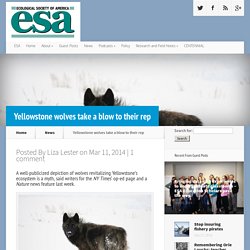
This is the story: For thousands of years, wolves shaped the ecology of Yellowstone. That changed in the twentieth century, when people succeeded in eradicating a competitor and perceived threat from the lower 48. In the predators’ absence, elk and deer overran the remaining wild lands, denuding streamside trees and shrubs, accelerating erosion, and degrading habitat for the birds and fish adapted to the old environment. With the repatriation of grey wolves from Canada to the park in 1995, elk relearned wariness while browsing on open ground; they could not bury their heads in the grass all of the time and also keep a lookout for danger on four paws. CERES Community Environment Park. Education John Camilleri 2016-04-21T01:41:59+00:00 Education lies at the heart of CERES, which has grown from its humble beginnings into one of the largest sustainability education providers in Victoria. CERES Education provides a wide range of services: Excursions – Come to CERES!
Incursions - Edendale Community Environment Farm. If your school is relatively local to the Eltham area, Edendale Education can also offer a range of our activities for incursion, including: Aquatic macro-invertebrates (waterbugs)Tale of the Creek (a whole class role-play)Growing Your Own FoodComposting and Worm FarmingFood FootprintHands-on Veggie Gardening (in your patch)Food Choices for the EnvironmentIndigenous Plant Propagation and Planting (seasonal)Who am I? Eltham Copper ButterflyConsumption Down! What a Load of RubbishA variety of environmental art activities. We also have access to several terrific short films that can be used in a discussion sessions with your class. Environmental Education in Early Childhood - Victoria - Home Page. Lesson Plans, Teacher Guides and Online Resources for Educators.
Find an array of environmental and science based lesson plans, activities and ideas below from EPA, other federal agencies and external organizations. Encontrar recursos para estudiantes y maestros. You will need Adobe Reader to view some of the files on this page. See EPA’s About PDF page to learn more.
Acid Rain: A Teacher's Guide (PDF 56 pp, 4.6 MB) Lesson plan and activities from EPA for teachers on acid rain. Yarra Valley Water. We offer a variety of educational programs and resources for all schools in our district. Our programs are tailored to both primary and secondary levels and include educational materials for use by teachers and students, free school visits, tours and National Water Week events and competitions.
Choose Tap EducationAs part of the Choose Tap Education program, schools are able to get involved in different activities that will engage students and staff in learning about the benefits of drinking tap water.Find out more Resources for schoolsYarra Valley Water offers a range of different resources to schools in our district. We can assist you to successfully and easily implement water education into your curriculum with resources to borrow and resources to download and keep! Schools Water Efficiency Program (SWEP)The Schools Water Efficiency Program (SWEP) enables schools to track their water usage using data logger technology. Environment Education Resource Kit. RMIT Central Authentication Service.
RMIT Central Authentication Service.